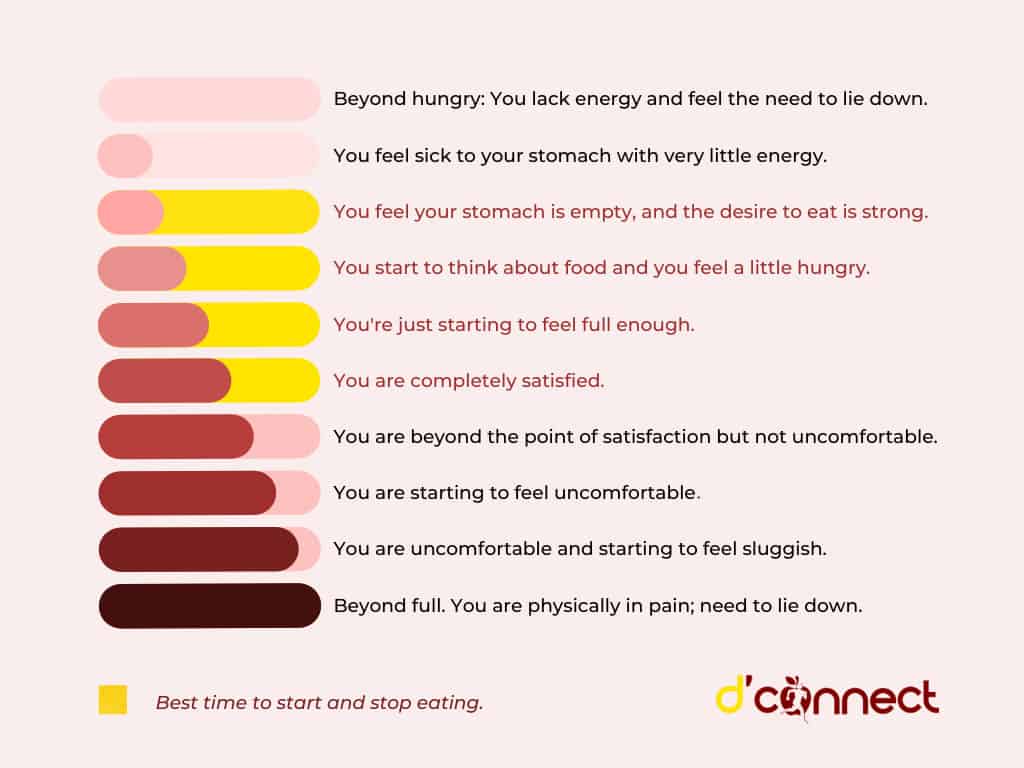
Tiana Hape-Cramond
(Associate Registered Nutritionist)
There are many approaches to eating – either how to eat or when to eat. The most important one should be addressing our relationship and mindset towards food.
Mindful eating is being present and attentive towards the food and drink that we are consuming at that moment. We eat slowly and relaxed, enjoying and savouring the food without any distractions.
Research has shown that a mindful approach to eating has many healthy benefits and assists with unhealthy habits and eating disorders.
Given that on average we spend nearly 5 years of our life on eating, and nearly 300 hours every year on thinking about food, it is important that we do it correctly and ensure that food enhances our health and life quality.
What is Mindful Eating?
Mindful eating is being fully conscious when eating food. Meaning, making eating an experience and focusing on the sensual awareness of the food being eaten. The purpose of mindful eating is to savour the food and be aware of what we are putting in our body.
Mindful eating encompasses five principles: reducing the eating rate, assessing hunger and satiety cues, reducing portion sizes, reducing distractions while eating and savoring food.[1]
1. Eating Rate
Reducing eating rate allows time for satiety signals to reach the brain and gives the body time to process the food and indicate when it is full.
2. Assessing Hunger and Satiety Cues
This principle relates to the eating rate. Eating food slowly allows us to check regularly if the stomach is full by listening to the body’s own cues.[1]
3. Portion Sizes
Researchers have found that reducing portion sizes and size of plates can decrease the likelihood of overeating.[2] This demonstrates that people rely on external cues to determine fullness.
4. Distractions
Being distracted while eating can reduce the ability to sense internal cues, which can increase the likelihood of overeating.
5. Savoring Food
Using all senses to enjoy foods that are pleasing.[1] Thinking of what the food looks like and the aroma of the food make the experience of eating more enjoyable.
Research behind Mindful Eating
Research around mindful eating has involved mindful meditation and the application of these mindful practices when eating food. Research has been applied to areas such as disordered eating, weight loss and management, and psychological outcomes of mindful eating, which have proven that eating mindfully has many benefits.
These benefits include:

A systematic review was conducted in 2016 that looked at the effect of mindfulness practices on weight loss and health-related behaviors in adults that were either overweight or obese.
RELATED — Intermittent Fasting: The Medicine of Old
Analysis of the 12 studies found evidence to suggest that mindfulness may reduce behaviors relating to binge eating, impulsive eating and increased physical activity. However, the studies found no effects of mindfulness on weight loss.[6]
Mindful practices can assist Mindful Eating reduce food cravings
Jordan et al. conducted 4 studies to gauge the effect of mindfulness on creating healthier eating behaviors. This study concluded that healthy eating behaviors can be achieved by mindfulness through reduced calorie consumption. It also found that generic mindfulness training may enhance healthy eating.[7]
Difference between Mindful Eating and Intuitive Eating
Mindful eating and Intuitive eating may sometimes be used interchangeably by those who do not fully understand the difference between the two. But there is a difference between intuitive eating and mindful eating.[8]
Intuitive eating is a 10-principle practice which reconnects the body with food to help develop a stronger relationship with food. Intuitive eating includes mindful eating as one of the principles.
Mindful eating involves being conscious when eating and paying specific attention to the eating experience.
The main difference between intuitive eating and mindful eating is that intuitive eating is a lifestyle change. It encompasses many aspects of well-being and promotes a healthier lifestyle. Mindful eating focuses mainly on the relationship between food, the mind, and the body and being fully in the moment of eating and enjoying food.[9]
RELATED — The Ultimate Guide to Intuitive Eating
Another difference between intuitive eating and mindful eating is that intuitive eating is a more rounded approach that includes many different aspects outside of eating, such as physical activity and promoting positive body acceptance, but mindful eating prioritizes the moment of eating and food.[9]
There are similarities between mindful eating and intuitive eating, such as assessing hunger cues and savoring the food.
A combination of both is the most effective way to get the full benefits of mindful and intuitive eating and can be seen with the inclusion of mindful eating within intuitive eating principles.[8]
The combination of mindful eating and intuitive eating can be used to treat eating disorders and guide healthy lifestyles.
Difference between Mindful Eating and Dieting
Mindful eating involves judgment-free eating where an individual slows down and enjoys the food. However, dieting is the opposite of this practice.
Dieting is judgement driven and restricts caloric dense foods. Dieting implies that some foods are “good” and others are “bad”. Mindful eating removes these food labels and allows for the enjoyment of food.[10]
Dieting uses food as a tool towards weight loss and prioritizes restricting foods and limiting intake. This differs from mindful eating as it prioritizes quality, which means savoring the food and the moment in which the food is consumed.
Paying direct attention to the food as it is eaten can reduce the consumption of low quality and highly processed foods as the person doesn’t enjoy it as much.[11]
Similarly, dieting and mindful eating can both achieve weight loss. However, using a diet can lead to putting the lost weight back on when the adherence to the diet wears.
Mindful eating, on the other hand, is a sustainable eating habit and lifestyle which allows for not only weight loss but also weight maintenance.
What are the health benefits of Mindful Eating?
Better listening to body cues
A greater connection to the body and listening to internal cues produced by the body enable people to become more reliant on these cues for managing hunger and satiety. Mindful eating is used to explore and experience a meal which can prevent overeating and increase awareness for healthy eating.[3]
Reduced obesity
Obesity is becoming a large issue world wide.[12] With increasing rates of obesity it is important to find ways to tackle obesity. Mindful eating is one of these solutions as it reduces overeating and emotional eating.[4]
By using mindful practices to scan the body and reflect on the hunger scale, people are likely to decrease overeating tendencies.
RELATED — What is HAES: Does it promote obesity and is it healthy
Increased self-esteem
Mindful eating can help us achieve increased self-esteem by treating food and the body with compassion and non-judgment.[13] Mindful eating practices allow the mind to appreciate the food being consumed. Food is viewed as nourishment for the body and removing the judgments around food can be used to treat disordered eating.
Increased awareness of possible triggers to emotional eating
Awareness of possible triggers is a benefit of mindful eating. Identification of these triggers allows for the mind to target these triggers and address them appropriately. Mindful eating uses mental scanning of the body to identify the needs and wants in order to address them.
Reduced overeating
Overeating can pose an increased risk for obesity. Mindful eating helps identify the reasons for eating and focuses on eating when the body is hungry rather than boredom or emotions.
Overeating can occur in response to emotional cues rather than physical cues. Mindful eating identifies the difference between these cues and leads the body to eat only when needed.
Reduced food cravings
When allowing the body to consume any food that it would like, cravings for food are reduced. By eating mindfully and reflecting on the reasons why the body is craving food, it can either deter an individual from eating the food or the individual will savor the food and decrease the amount of food in order to be satisfied.[5]
Decreased stress and depression
Mindful eating has been linked to decreased levels of stress and depression. A study found that mindful-based intervention can reduce cortisol and pro-inflammatory cytokines.[14]
High cortisol is strongly associated with stress and anxiety. The link around mindful eating and depression is limited, but the link between mindfulness and stress reduction has been researched.[15]
Increased enjoyment
Enjoyment is an important part of the eating experience that can be lost when eating becomes a chore and negative emotions become associated with food. Mindful eating means being in the moment of eating and appreciating the food.
Applying all the senses while eating amplifies the enjoyment of eating. Focusing on the taste, smell and look of food can increase anticipation of consuming food, which increases the satisfaction of eating.[1] Increased enjoyment leads to increased quality of living.
Diabetes management
It has been found that mindful eating may benefit those with diabetes through food management. Through awareness and paying attention to the moment when food is consumed, people can react reflexively rather than continuing their habitual eating behaviors.[16]
RELATED — Diabetes: Early Signs, Causes, Types and Treatment
Including mindful eating into diabetes management may be beneficial in regulating eating behaviors which can help improve quality of life in diabetics.[17]
How mindful eating can help with eating disorders
It has been suggested that disordered eating behaviors may arise when people have trouble regulating their emotional experience and often associate food consumption with negative emotions.[18]
Mindful eating interventions aim to improve the emotional connection with food and build on awareness of hunger and satiety cues.[3] Mindfulness skills are used to increase awareness of emotional and physical states and respond in a non-judgemental way.[13]
An example of this practice is mindful breathing and reflecting on whether our body has any physiological hunger cues.
RELATED — Understanding Eating Disorders – History, Types and Statistics
Mindful eating can be useful for the treatment of eating disorders as it creates a neutral space around eating and a respect for food.[19]
Mindful eating and bulimia
Those who suffer from bulimia exhibit behaviors of extreme dieting, excessive exercising, self-induced vomiting, or taking laxatives. Bulimia patients also have the characteristics of extreme body image issues and concerns around weight.[20]
Mindful eating could be a therapeutic technique for those who suffer from bulimia as it encourages regulation of internal experiences.[18]
A study has found that using a mindful program to treat and manage bulimia was successful in increasing self-awareness and acceptance, resulting in less emotional stress and increased regulation of emotions.[21]
Another study was performed on 33 women – 10 with bulimia, 17 with anorexia and 6 participants with eating disorder not otherwise specified (EDNOS) – which demonstrated that mindful eating interventions can reduce obsessive thoughts and disordered eating traits.[18]
Mindful eating and anorexia
Individuals who have anorexia nervosa often have problems with regulation skills and emotional awareness. Mindful eating aims to enable emotional regulation, which can have therapeutic benefits for anorexia.[13]
A case study was performed on a 19-year-old woman who had been identified with anorexia, and the treatment involved 15 sessions of mindful eating skills.
The mindfulness skills taught were tasting the food, being mindful of hunger, being in the moment while eating, letting go of thoughts, accepting food, hunger, and body image and compassion and non-judgmental towards the “eating disorder voice” that anorexic patients have.
After learning these mindful eating skills, her BMI increased, and she reported increased quantity and variety of foods.[13]
Mindful eating and how to stop Binge Eating
Mindfulness has the potential to be used for facilitation of self-regulation, and may enhance insight on physiological, emotional, cognitive, and behavioral functions. This can then be implemented to identify and target patterns of dysregulated behavior and emotion.[22]
RELATED — Binge Eating disorder: Is it a mental illness or an excuse to overeat?
In 1999, a study was conducted on 18 obese women who used mindful meditation for a 6-week period in order to reduce binge eating. The mindful meditation included general meditation, eating meditation and mini meditation.
This study found that mindful meditation can improve mood and decrease binge eating from 4 episodes a week to 1.5 episodes a week.[22]
Weight loss and Mindful Eating (What is the Hunger Scale)
Mindful eating has been used to decrease negative eating behaviours that are associated with obesity and overweight.[1]
Hunger Scale is a tool that can be used to monitor how hungry the body is. Being able to understand the body’s hunger scale leads to understanding the purpose of eating.

Weight loss can be achieved using mindful eating as it uses body scanning in order to gauge the body’s internal cues to determine hunger.[23] This leads to a decrease in overeating or eating when not hungry.
Mindful Eating decreases negative eating behaviours
When mindful eating was applied to an obese population, weight loss was observed and a reduction in C-reactive protein, which is an indicator of inflammation.[13]
Mindful eating does not restrict caloric intake but instead promotes learning to listen to the body.
Therefore, mindful eating can be a more sustainable option for weight loss as it encourages weight maintenance through the continued listening to hunger and satiety cues.
How to start Mindful Eating (step-by-step)
Reduce eating rate – take smaller bites when eating and chew food slowly. Take time to pause between mouthfuls and drink water.
Use hunger and satiety cues – think about the reasons for eating and use the hunger scale to assess hunger levels.
Reduce portion size – use smaller plates and bowls to serve food. This allows for smaller portions sizes, which means that there’s time in between to think about hunger levels before getting another portion.
RELATED — The Healthy Plate model: Essentials of Healthy Eating
Reduce distractions – turn off all distractions. Sit at a table with the tv and music off. This allows for full attention to enjoy the food and the experience.
Savor food – use all the senses to enjoy food to create a positive and pleasurable environment for eating.
Stop and think – this means that before eating, stop and think about why the body is feeling hungry. Reflect on the body’s needs and wants.
Related Questions
1. What are some great mindful eating recipes?
Mindful eating focuses on changing behavior and being in the moment when eating. There are no “mindful eating recipes”, but check out our Recipes pages for great ideas on healthy meals.
2. What are the most helpful mindful eating apps?
A review was conducted to discover the best app and based on their scale, some useful apps include Mindful Eating Coach: Am I Hungry? and In the Moment.
The study concluded that although these apps lacked comprehensiveness, they did include hunger rating scales which help with beginning a mindful eating journey.[26]
Mindful eating apps are a helpful way to bring mindful eating principles into practice. They allow people to have access to a food diary to log their emotions and experiences with food and a hunger rating scale that is easy to access and convenient.[26]
3. Can meditation help with mindful eating?
Meditation is an important aspect of mindful eating. This is implemented in mindful eating as it provides a moment to reflect and be fully within the experience.[22]
RELATED — Introduction to Meditation: Ancient medicine for mind and body healing
Meditation breathing exercises have also been used within the treatment of patients with eating disorders in order to centre themselves and acknowledge their feelings to move forward.[19]
I hope you liked the article. If you would like to know when similar articles will be coming out, you can Subscribe to our Newsletter. In the meantime, please share the article with your family and friends because it makes a good reminder how we should perceive food.
Tiana is an Associate Registered Nutritionist who has a passion for public health and education. Working towards a Master’s in Nutrition Practice with a Bachelor’s in Human Nutrition, Tiana has a personal interest in healthy heart nutrition and promoting positive lifestyle behaviours.
Tiana is a part of the Content Team that brings you the latest news here at D’Connect.
References
(1) Monroe JT. Mindful eating: principles and practice. American Journal of Lifestyle Medicine. 2015 May;9(3):217-20.
(2) Wansink B, Painter JE, North J. Bottomless bowls: why visual cues of portion size may influence intake. Obesity research. 2005 Jan;13(1):93-100.
(3) Smith BW, Shelley BM, Sloan AL, Colleran K, Erickson K. A preliminary randomized controlled trial of a mindful eating intervention for post-menopausal obese women. Mindfulness. 2018 Jun;9(3):836-49.
(4) Dalen J, Smith BW, Shelley BM, Sloan AL, Leahigh L, Begay D. Pilot study: Mindful Eating and Living (MEAL): weight, eating behavior, and psychological outcomes associated with a mindfulness-based intervention for people with obesity. Complementary therapies in medicine. 2010 Dec 1;18(6):260-4.
(5) Warren JM, Smith N, Ashwell M. A structured literature review on the role of mindfulness, mindful eating and intuitive eating in changing eating behaviours: effectiveness and associated potential mechanisms. Nutrition research reviews. 2017 Dec;30(2):272-83.
(6) Ruffault A, Czernichow S, Hagger MS, Ferrand M, Erichot N, Carette C, Boujut E, Flahault C. The effects of mindfulness training on weight-loss and health-related behaviours in adults with overweight and obesity: A systematic review and meta-analysis. Obesity research & clinical practice. 2017 Sep 1;11(5):90-111.
(7) Jordan CH, Wang W, Donatoni L, Meier BP. Mindful eating: Trait and state mindfulness predict healthier eating behavior. Personality and Individual differences. 2014 Oct 1;68:107-11.
(8) Tribole, E. The difference between Intuitive Eating and Mindful Eating. The Original Intuitive Eating Pros. 2010 Nov 17. Retrieved from: https://www.intuitiveeating.org/the-difference-between-intuitive-eating-and-mindful-eating/
(9) Mageerd, H. Intuitive Eating & Mindful Eating: What’s the Difference? [Internet]. Hannah Magee RD. 2019 [cited 2021 Aug 30]. Available from: https://hannahmageerd.com/intuitive-eating-vs-mindful-eating-difference/
(10) Abram, T.Mindful Eating vs. Dieting: Part two [Internet]. MSU Extension. 2016 [cited 2021 Aug 30]. Available from: https://www.canr.msu.edu/news/mindful_eating_vs_dieting_part_two
(11) Dennett C. Mindful eating vs. dieting | Nutrition By Carrie [Internet]. Nutrition By Carrie. 2013 [cited 2021 Aug 30]. Available from: https://www.nutritionbycarrie.com/2013/12/mindful-eating-vs-dieting.html
(12) World Health Organization: WHO. Obesity and overweight [Internet]. Who.int. World Health Organization: WHO; 2021 [cited 2021 Sep 2]. Available from: https://www.who.int/news-room/fact-sheets/detail/obesity-and-overweight
(13) Albers S. Using mindful eating to treat food restriction: A case study. Eating Disorders. 2010 Dec 28;19(1):97-107.
(14) Pascoe MC, de Manincor M, Tseberja J, Hallgren M, Baldwin PA, Parker AG. Psychobiological mechanisms underlying the mood benefits of meditation: A Narrative Review. Comprehensive Psychoneuroendocrinology. 2021 Mar 10:100037.
(15) Godman H. 11 Benefits of Mindful Eating [Internet]. US News & World Report. U.S. News & World Report; 2019 [cited 2021 Aug 29]. Available from: https://health.usnews.com/wellness/food/articles/benefits-of-mindful-eating
(16) Miller CK. Mindful eating with diabetes. Diabetes Spectrum. 2017 May 1;30(2):89-94.
(17) Miller CK, Kristeller JL, Headings A, Nagaraja H. Comparison of a mindful eating intervention to a diabetes self-management intervention among adults with type 2 diabetes: a randomized controlled trial. Health Education & Behavior. 2014 Apr;41(2):145-54.
(18) Hepworth NS. A mindful eating group as an adjunct to individual treatment for eating disorders: A pilot study. Eating Disorders. 2010 Dec 28;19(1):6-16.
(19) Mathieu J. What should you know about mindful and intuitive eating?. Journal of the American Dietetic Association. 2009 Dec 1;109(12):1985.
(20) Fairburn CG, Garner DM. The diagnosis of bulimia nervosa. International Journal of Eating Disorders. 1986 Mar;5(3):403-19.
(21) Proulx K. Experiences of women with bulimia nervosa in a mindfulness-based eating disorder treatment group. Eating Disorders. 2007 Dec 26;16(1):52-72.
(22) Kristeller JL, Hallett CB. An exploratory study of a meditation-based intervention for binge eating disorder. Journal of health psychology. 1999 May;4(3):357-63.
(23) Kristeller JL, Wolever RQ. Mindfulness-based eating awareness training for treating binge eating disorder: the conceptual foundation. Eating disorders. 2010 Dec 28;19(1):49-61.
(24) Nelson JB. Mindful eating: the art of presence while you eat. Diabetes Spectrum. 2017 Aug 1;30(3):171-4.
(25) Psychology L. Mindful Eating: The Raisin Exercise (Mindfulness Based Cognitive Therapy) #LewisPsychology [Internet]. YouTube. 2020 [cited 2021 Sep 4]. Available from: https://www.youtube.com/watch?v=1umGZ8S8tHo
(26) Lyzwinski LN, Edirippulige S, Caffery L, Bambling M. Mindful eating mobile health apps: review and appraisal. JMIR mental health. 2019;6(8):e12820.
(27) The Top 10 Mindful Eating Apps – Sol Food [Internet]. Sol Food. 2018 [cited 2021 Sep 2]. Available from: https://www.solfood.com.au/mindful-eating-apps/






